Mechanical, Electrical, and Tensile Self-Sensing Properties of Ultra-High-Performance Concrete Enhanced with Sugarcane Bagasse Ash
Abstract
:1. Introduction
2. Experimental Program
2.1. Manufacturing Process of SCBA
2.2. Constituent Material
2.3. Specimen Preparation
2.4. Test Setup and Procedure
2.4.1. Workability Test
Mechanical Tests
2.4.2. Electrical Resistance Tests
2.4.3. Tensile Self-Sensing Tests
3. Experimental Results and Discussion
3.1. Workability and Mechanical Properties
3.2. Electrical Properties
3.3. Tensile Self-Sensing Properties
3.3.1. Single-Cyclic Tension
3.3.2. Multi-Cyclic Tension
4. Tensile Self-Sensing Model and Mechanism
4.1. Mechanics–Electricity Model
4.2. Self-Sensing Mechanism
5. Conclusions
- Among various calcination temperatures (300 °C, 600 °C, and 900 °C), SCBA calcined at 600 °C resulted in the lowest workability of UHPC, with a fluidity of 191 mm and a consistency of 44 mm. This could be attributed to its significantly higher specific surface area of 267.177 m2/g, surpassing that achieved at 300 °C and 900 °C;
- Adding processed SCBA below 3.0 wt% could improve the mechanical properties of UHPC by promoting denser hydration products such as calcium silicate and calcium aluminate hydrates. The addition of 3.0 wt% SCBA into UHPC resulted in the most significant enhancement of its compressive, flexural, and tensile strength, with improvements of 13.1%, 17.4%, and 20.6%, respectively, compared to UHPC that only contained steel fibers without SCBA. However, excessive incorporation of SCBA adversely affected the mechanical properties of UHPC. Adding 9.0 wt% SCBA degraded the compressive, flexural, and tensile strengths by 11.1%, 14.8%, and 8.5%, respectively;
- The addition of SCBA influenced the electrical resistivity of UHPC, with a critical threshold value of 0.3 wt% for SCBA. Below this threshold, the resistivity of UHPC increased as SCBA content increased, caused by the negative effect of SCBA, wherein hydration products could disrupt the connection between conductive fillers. However, surpassing the 0.3 wt% threshold, the resistivity of UHPC decreased significantly, attributed to the positive effect, as the excess SCBA could reduce the proximity of adjacent conductive fillers;
- UHPC containing SCBA demonstrated superior tensile stress-sensing properties compared to SCBA-free UHPC, exhibiting improved linearity and reversibility, lower hysteresis, higher sensitivity, and excellent repeatability. Among the various SCBA contents tested, UHPC with 0.3 wt% SCBA achieved the best linearity, with values of 8.8% for loading and 17.0% for unloading, respectively, which were significantly lower than those for SCBA-free UHPC, which were 14.0% and 60.0%, respectively. Additionally, UHPC with 0.9 wt% SCBA exhibited the lowest hysteresis and repeatability, with values of 13.3% and 5.3%, respectively, which were much lower than those for SCBA-free UHPC, which were 50% and 51.6%, respectively;
- The relationship between FCR and tensile stress during loading was significantly more linear compared to unloading regardless of the SCBA contents. This could be attributed to the irreversible degradation of the interfaces between the conductive fillers or the emergence of micro-damages in the matrix during loading;
- Overall, an SCBA content of 0.9 wt% was proven to be the most effective in improving the overall performance of UHPC, including improvements in mechanical, electrical, and tensile self-sensing performance.
Author Contributions
Funding
Institutional Review Board Statement
Informed Consent Statement
Data Availability Statement
Conflicts of Interest
References
- Yang, Y.; Xu, W.; Gao, Z.; Yu, Z.; Zhang, Y. Research progress of SHM system for super high-rise buildings based on wireless sensor network and cloud platform. Remote Sens. 2023, 15, 1473. [Google Scholar] [CrossRef]
- Khazaee, M.; Derian, P.; Mouraud, A. A comprehensive study on Structural Health Monitoring (SHM) of wind turbine blades by instrumenting tower using machine learning methods. Renew. Energy 2022, 199, 1568–1579. [Google Scholar] [CrossRef]
- Siahkouhi, M.; Wang, J.; Han, X.; Aela, P.; Ni, Y.-Q.; Jing, G. Railway ballast track hanging sleeper defect detection using a smart CNT self-sensing concrete railway sleeper. Constr. Build. Mater. 2023, 399, 132487. [Google Scholar] [CrossRef]
- Jing, G.; Siahkouhi, M.; Riley Edwards, J.; Edwards, J.R.; Dersch, M.S.; Hoult, N. Smart railway sleepers—A review of recent developments, challenges, and future prospects. Constr. Build. Mater. 2021, 271, 121533. [Google Scholar] [CrossRef]
- Han, B.G.; Wang, Y.Y.; Dong, S.F.; Zhang, L.; Ding, S.; Yu, X.; Ou, J. Smart concretes and structures: A review. J. Intell. Mater. Syst. Struct. 2015, 26, 1303–1345. [Google Scholar] [CrossRef]
- Wen, S.; Chung, D.D.L. Uniaxial compression in carbon fiber reinforced cement, sensed by electrical resistivity measurement in longitudinal and transverse directions. Cem. Concr. Res. 2001, 31, 297–301. [Google Scholar] [CrossRef]
- Chung, D.D.L. Damage in cement-based materials, studied by electrical resistance measurement. Mater. Sci. Eng. R. Rep. 2003, 42, 1–40. [Google Scholar] [CrossRef]
- Wang, Y.L.; Chung, D.D.L. Capacitance-based defect detection and defect location determination for cement-based material. Mater. Struct. 2017, 50, 237. [Google Scholar] [CrossRef]
- Madbouly, A.I.; Mokhtar, M.M.; Morsy, M.S. Evaluating the performance of rGO/cement composites for SHM applications. Constr. Build. Mater. 2020, 250, 118841. [Google Scholar] [CrossRef]
- Han, B.G.; Ding, S.; Yu, X. Intrinsic self-sensing concrete and structures: A review. Measurement 2015, 59, 110–128. [Google Scholar] [CrossRef]
- Chung, D.D.L. Self-monitoring structural materials. Mater. Sci. Eng. R-Rep. 1998, 22, 57–78. [Google Scholar] [CrossRef]
- Ou, J.P.; Baoguo, H. Piezoresistive cement-based strain sensors and self-sensing concrete components. J. Intell. Mater. Syst. Struct. 2009, 20, 329–336. [Google Scholar] [CrossRef]
- Banthia, N.; Djeridane, S.; Pigeon, M. Electrical resistivity of carbon and steel micro-fiber reinforced cements. Cem. Concr. Res. 1992, 22, 804–814. [Google Scholar] [CrossRef]
- Lee, S.; You, I.; Zi, G.; Yoo, D.-Y. Experimental investigation of the piezoresistive properties of cement composites with hybrid carbon fibers and nanotubes. Sensors 2017, 17, 2516. [Google Scholar] [CrossRef] [PubMed]
- Yoo, D.-Y.; You, I.; Lee, S.-J. Electrical properties of cement-based composites with carbon nanotubes, graphene, and graphite nanofibers. Sensors 2017, 17, 1064. [Google Scholar] [CrossRef] [PubMed]
- Ramachandran, K.; Vijayan, P.; Murali, G.; Vatin, N.I. A Review on Principles, Theories and materials for self sensing concrete for structural applications. Materials 2022, 15, 3831. [Google Scholar] [CrossRef] [PubMed]
- Chung, X.F.A.D. Self-monitoring of fatigue damage in carbon fiber reinforced cement. Cem. Concr. Res. 1996, 26, 15–20. [Google Scholar]
- Du, J.; Meng, W. New development of ultra-high-performance concrete (UHPC). Compos. Part. B Eng. 2021, 224, 109220. [Google Scholar] [CrossRef]
- Song, F.; Li, Q.; Xu, S. A review of self-sensing ultra-high performance concrete: Towards next-generation smart structural materials. Cem. Concre. Compos. 2023, 145, 105350. [Google Scholar] [CrossRef]
- Song, F.; Chen, Q.; Zheng, Q. Multifunctional ultra-high performance fiber-reinforced concrete with integrated self-sensing and repair capabilities towards in-situ structure monitoring. Compos. Struct. 2023, 321, 117240. [Google Scholar] [CrossRef]
- Lee, S.; You, I.; Kim, S.; Shin, H.-O.; Yoo, D.-Y. Self-sensing capacity of ultra-high-performance fiber-reinforced concrete containing conductive powders in tension. Cem. Concr. Compos. 2022, 125, 104331. [Google Scholar] [CrossRef]
- Yoo, D.; Kim, S.; Lee, S.H. Self-sensing capability of ultra-high-performance concrete containing steel fibers and carbon nanotubes under tension. Sens. Actuator A Phys. 2018, 276, 125–136. [Google Scholar] [CrossRef]
- Kim, M.K.; Kim, D.J.; An, Y. Electro-mechanical self-sensing response of ultra-high-performance fiber-reinforced concrete in tension. Compos. Part. B Eng. 2018, 134, 254–264. [Google Scholar] [CrossRef]
- Wu, P.; Sun, M.Q.; Wang, Y.J. Study on tensile sensitivity of ultra-high performance concrete. Bull. Ch. Ceram. Soc. 2019, 38, 1331–1335. [Google Scholar] [CrossRef]
- Siahkouhi, M.; Razaqpur, G.; Hoult, N.; Baghban, M.H.; Jing, G. Utilization of carbon nanotubes (CNTs) in concrete for structural health monitoring (SHM) purposes: A review. Constr. Build. Mater. 2021, 309, 125137. [Google Scholar] [CrossRef]
- Frías, M.; Villar, E.; Savastano, H. Brazilian sugar cane bagasse ashes from the cogeneration industry as active pozzolans for cement manufacture. Cem. Concr. Compos. 2011, 33, 490–496. [Google Scholar] [CrossRef]
- Torres De Sande, V.; Sadique, M.; Pineda, P.; Bras, A.; Atherton, W.; Riley, M. Potential use of sugar cane bagasse ash as sand replacement for durable concrete. J. Build. Eng. 2021, 39, 102277. [Google Scholar] [CrossRef]
- Ahmad, W.; Ahmad, A.; Ostrowski, K.A.; Aslam, F.; Joyklad, P.; Zajdel, P. Sustainable approach of using sugarcane bagasse ash in cement-based composites: A systematic review. Case Stud. Constr. Mater. 2021, 15, e698. [Google Scholar] [CrossRef]
- França, S.; Figueiredo, P.F.; Sousa, L.N.; Silva, M.V.d.M.S.; Borges, P.H.R.; Bezerra, A.C.d.S. Reaction mechanisms in geopolymers produced from sugarcane bagasse ash. Constr. Build. Mater. 2023, 377, 131124. [Google Scholar] [CrossRef]
- Kolawole, J.T.; Babafemi, A.J.; Fanijo, E.; Paul, S.C.; Combrinck, R. State-of-the-art review on the use of sugarcane bagasse ash in cementitious materials. Cem. Concr. Compos. 2021, 118, 103975. [Google Scholar] [CrossRef]
- Xu, Q.; Ji, T.; Gao, S.J.; Yang, Z.; Wu, N. Characteristics and applications of sugar cane bagasse ash waste in cementitious materials. Materials 2019, 12, 39. [Google Scholar] [CrossRef] [PubMed]
- Quedou, P.G.; Wirquin, E.; Bokhoree, C. Sustainable concrete: Potency of sugarcane bagasse ash as a cementitious material in the construction industry. Case Stud. Constr. Mater. 2021, 14, e545. [Google Scholar] [CrossRef]
- Spósito, C.C.A.; Fazzan, J.; Rossignolo, J.; Bueno, C.; Spósito, F.; Akasaki, J.; Tashima, M. Ecodesign: Approaches for sugarcane bagasse ash mortars a Brazilian context. J. Clean. Prod. 2023, 385, 135667. [Google Scholar] [CrossRef]
- Martirena Hernandez, J.F.; Middendorf, B.; Gehrke, M.; Budelmann, H. Use of wastes of the sugar industry as pozzolana in lime-pozzolana binders: Study of the reaction. Cem. Concr. Res. 1998, 28, 1525–1536. [Google Scholar]
- Mali, A.K.; Nanthagopalan, P. Comminution: A supplementation for pozzolanic adaptation of sugarcane bagasse ash. J. Mater. Civ. Eng. 2021, 33, 04021343. [Google Scholar] [CrossRef]
- Maglad, A.M.; Amin, M.; Zeyad, A.M.; Tayeh, B.A.; Agwa, I.S. Engineering properties of ultra-high strength concrete containing sugarcane bagasse and corn stalk ashes. J. Mater. Res. Technol. 2023, 23, 3196–3218. [Google Scholar] [CrossRef]
- De Siqueira, A.A.; Cordeiro, G.C. Properties of binary and ternary mixes of cement, sugarcane bagasse ash and limestone. Constr. Build. Mater. 2022, 317, 126150. [Google Scholar] [CrossRef]
- Athira, G.; Bahurudeen, A. Rheological properties of cement paste blended with sugarcane bagasse ash and rice straw ash. Constr. Build. Mater. 2022, 332, 127377. [Google Scholar] [CrossRef]
- Thomas, B.S.; Yang, J.; Bahurudeen, A.; Abdalla, J.A.; Hawileh, R.; Hamada, H.M.; Nazar, S.; Jittin, V.; Ashish, D.K. Sugarcane bagasse ash as supplementary cementitious material in concrete: A review. Mater. Today Sustain. 2021, 15, 100086. [Google Scholar] [CrossRef]
- Lima, S.A.; Sales, A.; Almeida, F.C.R.; Moretti, J.P.; Portella, K.F. Concretes made with sugarcane bagasse ash: Evaluation of the durability for carbonation and abrasion tests. Ambiente Construído. 2011, 11, 201–212. [Google Scholar] [CrossRef]
- Hemkemeier, T.A.; Almeida, F.C.; Sales, A.; Klemm, A.J. Repair mortars with water treatment plant sludge (WTPS) and sugarcane bagasse ash sand (SBAS) for more eco-efficient and durable constructions. J. Clean. Prod. 2023, 386, 135750. [Google Scholar] [CrossRef]
- Cordeiro, G.C.; Toledo Filho, R.D.; Fairbairn, E.M.R. Effect of calcination temperature on the pozzolanic activity of sugar cane bagasse ash. Constr. Build. Mater. 2009, 23, 3301–3303. [Google Scholar] [CrossRef]
- Ribeiro, D.V.; Morelli, M.R. Effect of calcination temperature on the pozzolanic activity of brazilian sugar cane bagasse ash (SCBA). Mater. Res. 2014, 17, 974–981. [Google Scholar] [CrossRef]
- Cordeiro, G.C.; Andreão, P.V.; Tavares, L.M. Pozzolanic properties of ultrafine sugar cane bagasse ash produced by controlled burning. Heliyon 2019, 5, e2566. [Google Scholar] [CrossRef] [PubMed]
- Ouedraogo, M.; Sawadogo, M.; Sanou, I.; Barro, M.; Nassio, S.; Seynou, M.; Zerbo, L. Characterization of sugar cane bagasse ash from Burkina Faso for cleaner cement production: Influence of calcination temperature and duration. Results Mater. 2022, 14, 100275. [Google Scholar] [CrossRef]
- Praveenkumar, S.; Sankarasubramanian, G.; Sindhu, S. Strength, permeability and microstructure characterization of pulverized bagasse ash in cement mortars. Constr. Build. Mater. 2020, 238, 117691. [Google Scholar] [CrossRef]
- Cordeiro, G.C.; Tavares, L.M.; Toledo Filho, R.D. Improved pozzolanic activity of sugar cane bagasse ash by selective grinding and classification. Cem. Concr. Res. 2016, 89, 269–275. [Google Scholar] [CrossRef]
- Cordeiro, G.C.; Toledo Filho, R.D.; Tavares, L.M.; Fairbairn, E.D. Ultrafine grinding of sugar cane bagasse ash for application as pozzolanic admixture in concrete. Cem. Concr. Res. 2009, 39, 110–115. [Google Scholar] [CrossRef]
- Somna, R.; Jaturapitakkul, C.; Rattanachu, P.; Chalee, W. Effect of ground bagasse ash on mechanical and durability properties of recycled aggregate concrete. Mater. Des. (1980–2015) 2012, 36, 597–603. [Google Scholar] [CrossRef]
- Kallioinen, A.; Hakola, M.; Riekkola, T.; Repo, T.; Leskelä, M.; von Weymarn, N.; Siika-Aho, M. A novel alkaline oxidation pretreatment for spruce, birch and sugar cane bagasse. Bioresour. Technol. 2013, 140, 414–420. [Google Scholar] [CrossRef]
- Embong, R.; Shafiq, N.; Kusbiantoro, A.; Nuruddin, M.F. Effectiveness of low-concentration acid and solar drying as pre-treatment features for producing pozzolanic sugarcane bagasse ash. J. Clean. Prod. 2016, 112, 953–962. [Google Scholar] [CrossRef]
- De Soares, M.M.N.S.; Garcia, D.C.S.; Figueiredo, R.B.; Aguilar, M.T.P.; Cetlin, P.R. Comparing the pozzolanic behavior of sugar cane bagasse ash to amorphous and crystalline SiO2. Cem. Concr. Compos. 2016, 71, 20–25. [Google Scholar] [CrossRef]
- Jagadesh, P.; Ramachandramurthy, A.; Murugesan, R. Evaluation of mechanical properties of Sugar Cane Bagasse Ash concrete. Constr. Build. Mater. 2018, 176, 608–617. [Google Scholar] [CrossRef]
- Joshaghani, A.; Moeini, M.A. Evaluating the effects of sugar cane bagasse ash (SCBA) and nanosilica on the mechanical and durability properties of mortar. Constr. Build. Mater. 2017, 152, 818–831. [Google Scholar] [CrossRef]
- Wu, N.S.; Ji, T.; Huang, P.; Fu, T.; Zheng, X.; Xu, Q. Use of sugar cane bagasse ash in ultra-high performance concrete (UHPC) as cement replacement. Constr. Build. Mater. 2022, 317, 125881. [Google Scholar] [CrossRef]
- Andrade Neto, J.D.S.; de França, M.J.S.; Amorim Júnior, N.S.D.; Ribeiro, D.V. Effects of adding sugarcane bagasse ash on the properties and durability of concrete. Constr. Build. Mater. 2021, 266, 120959. [Google Scholar] [CrossRef]
- Subedi, S.; Arce, G.; Hassan, M.; Kumar, N.; Barbato, M.; Gutierrez-Wing, M.T. Influence of production methodology on the pozzolanic activity of sugarcane bagasse ash. MATEC Web Conf. 2019, 271, 7003. [Google Scholar] [CrossRef]
- Huang, P.; Huang, B.; Li, J.; Wu, N.; Xu, Q. Application of sugar cane bagasse ash as filler in ultra-high performance concrete. J. Build. Eng. 2023, 71, 106447. [Google Scholar] [CrossRef]
- ASTM C618; Standard Specification for Coal Fly Ash and Raw or Calcined Natural Pozzolan for Use in Concrete. ASTM International: West Conshohocken, PA, USA, 2012. [CrossRef]
- Chinese T/CECS 864-2021; China Association for Engineering Construction Standardization. Standard for Test Methods of Ultra-High-Performance Concrete. China Architecture & Building Press: Beijing, China, 2021.
- Qiu, L.; Dong, Q.; Yu, X.; Han, B.G. Self-sensing ultra-high performance concrete for in-situ monitoring. Sens. Actuators A: Phys. 2021, 331, 113049. [Google Scholar] [CrossRef]

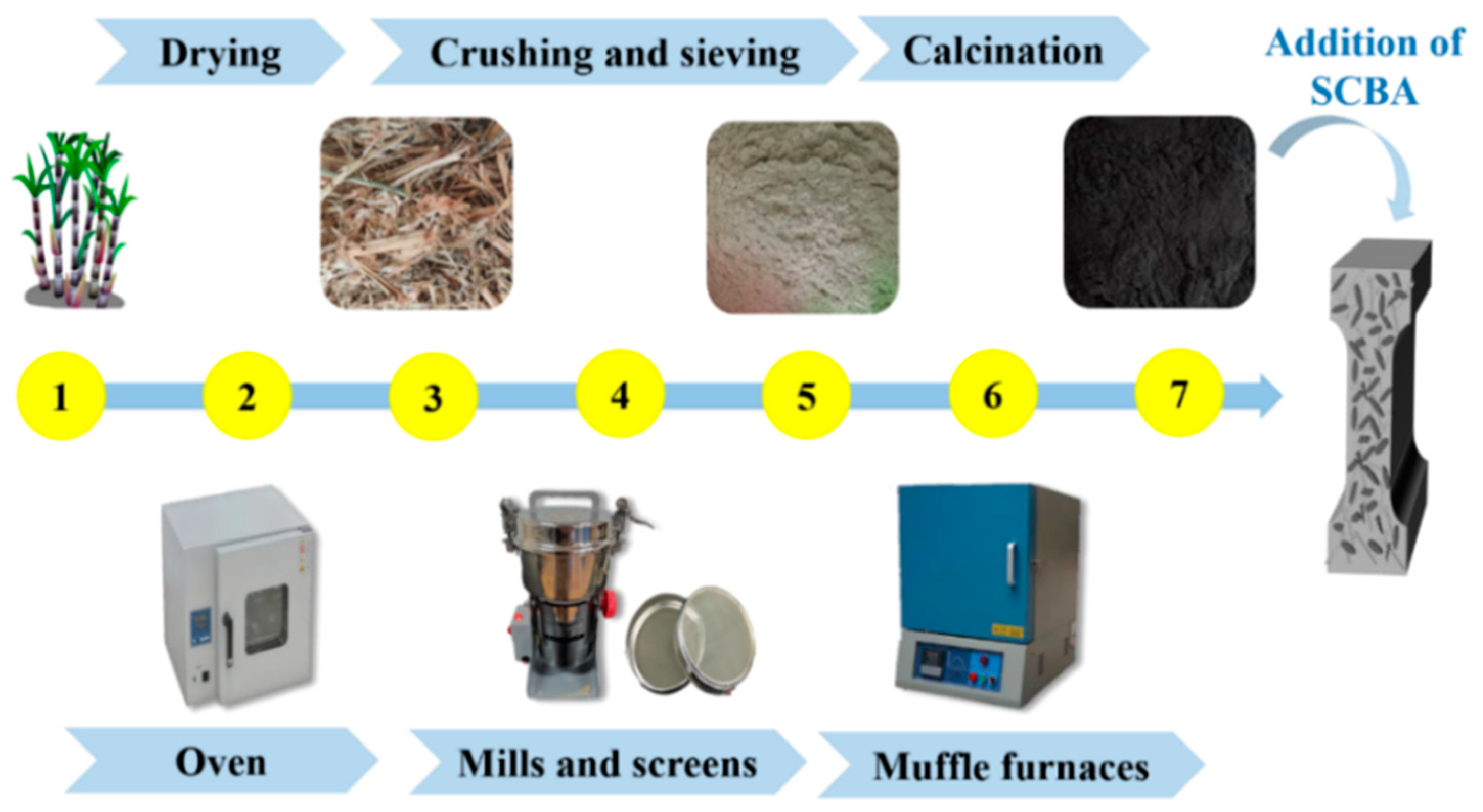
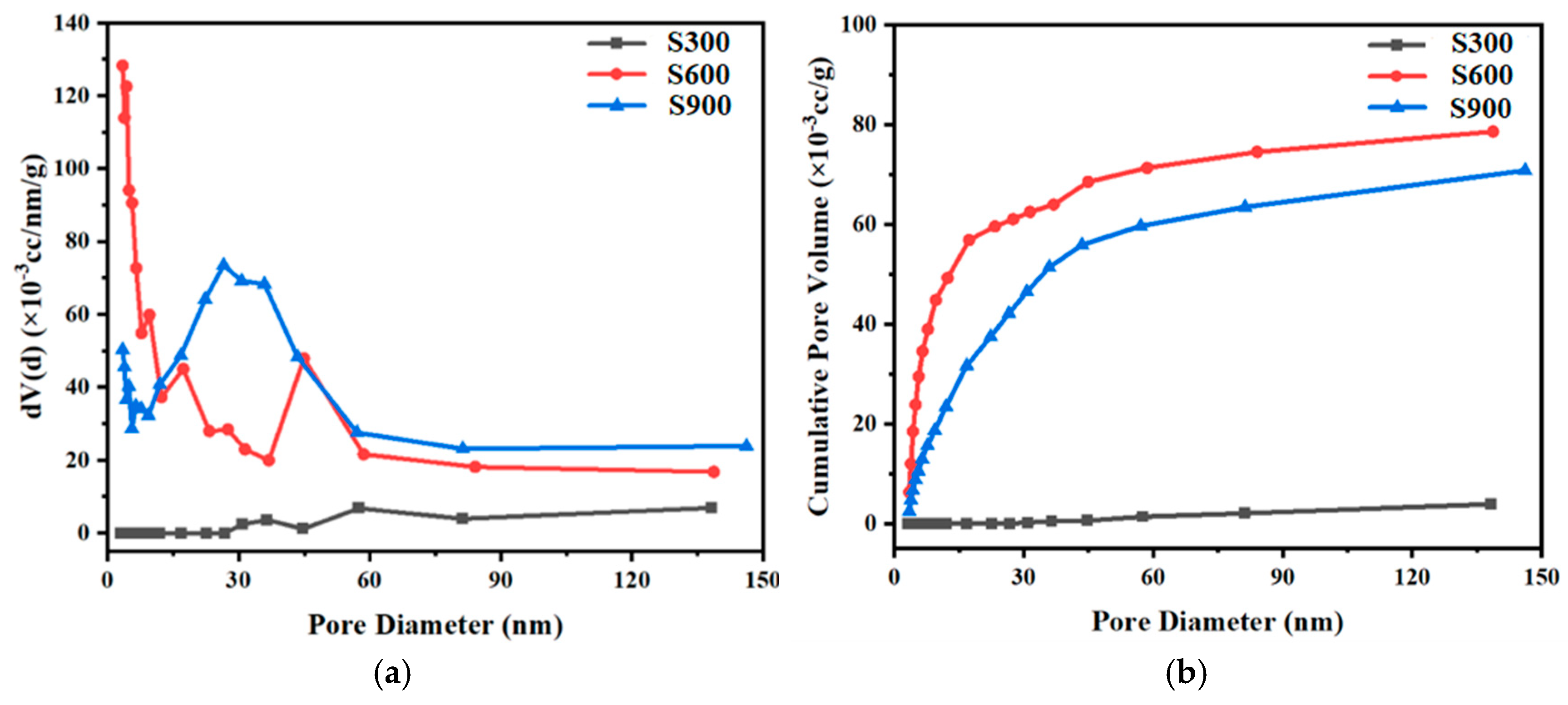

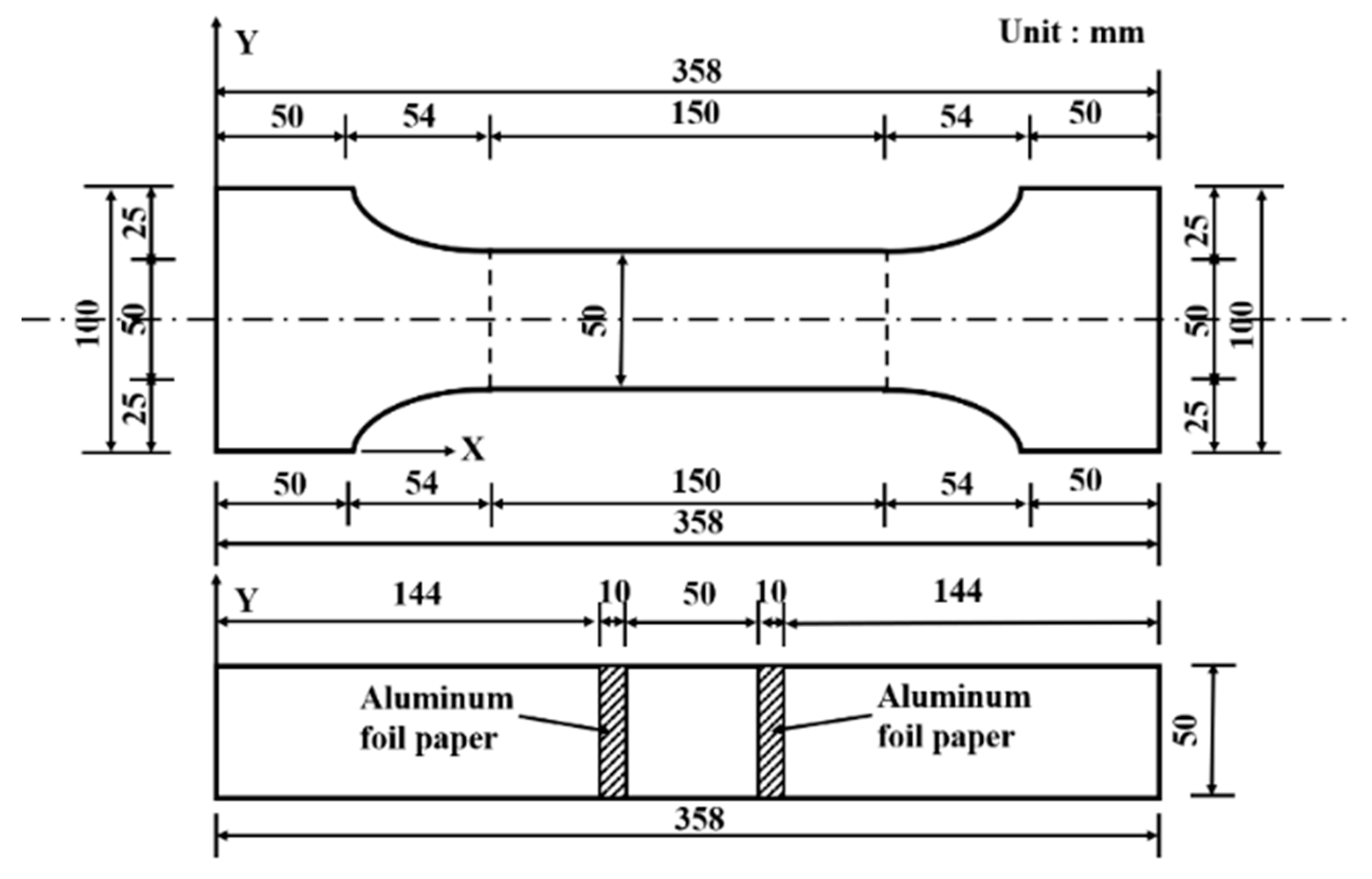


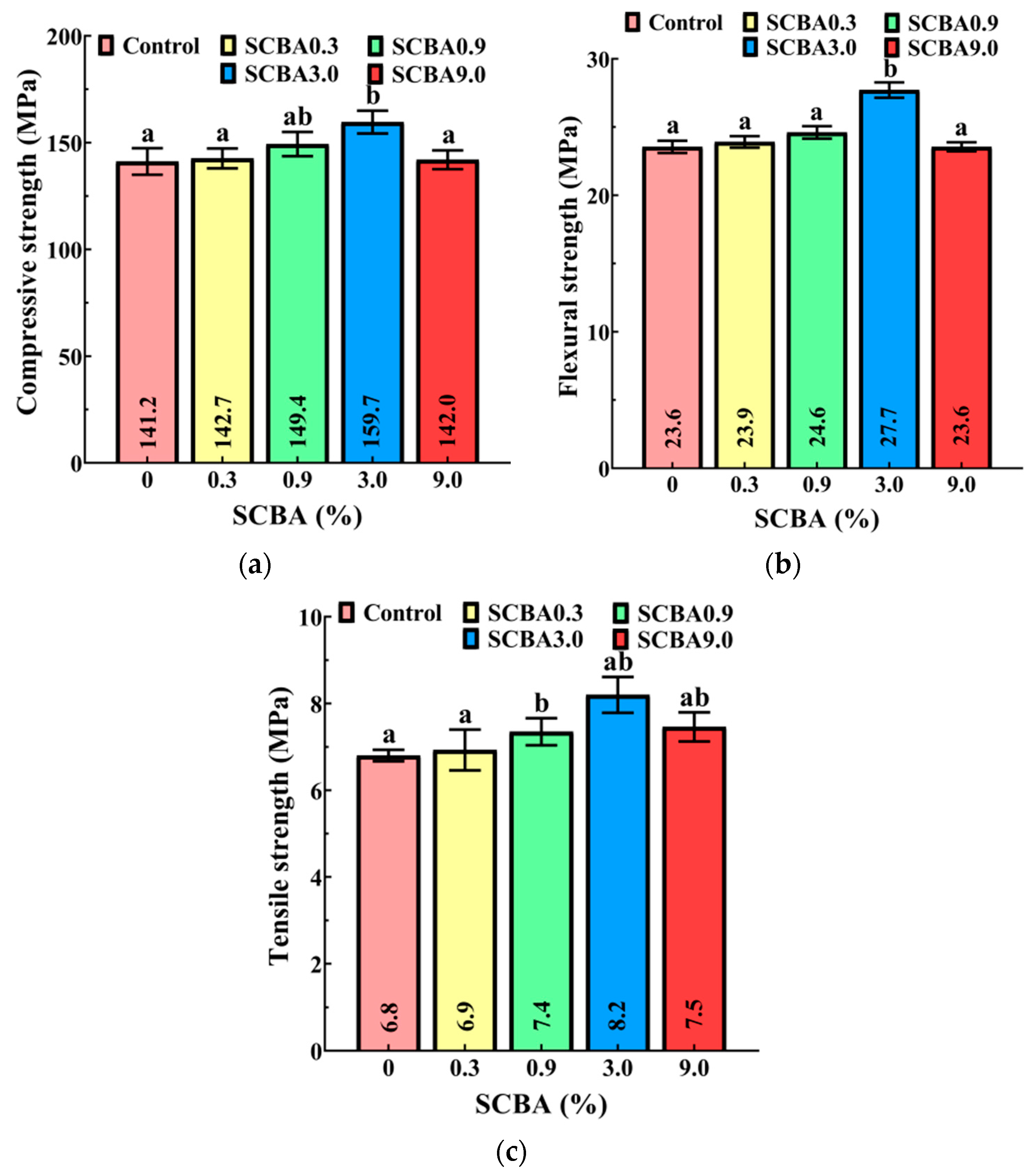

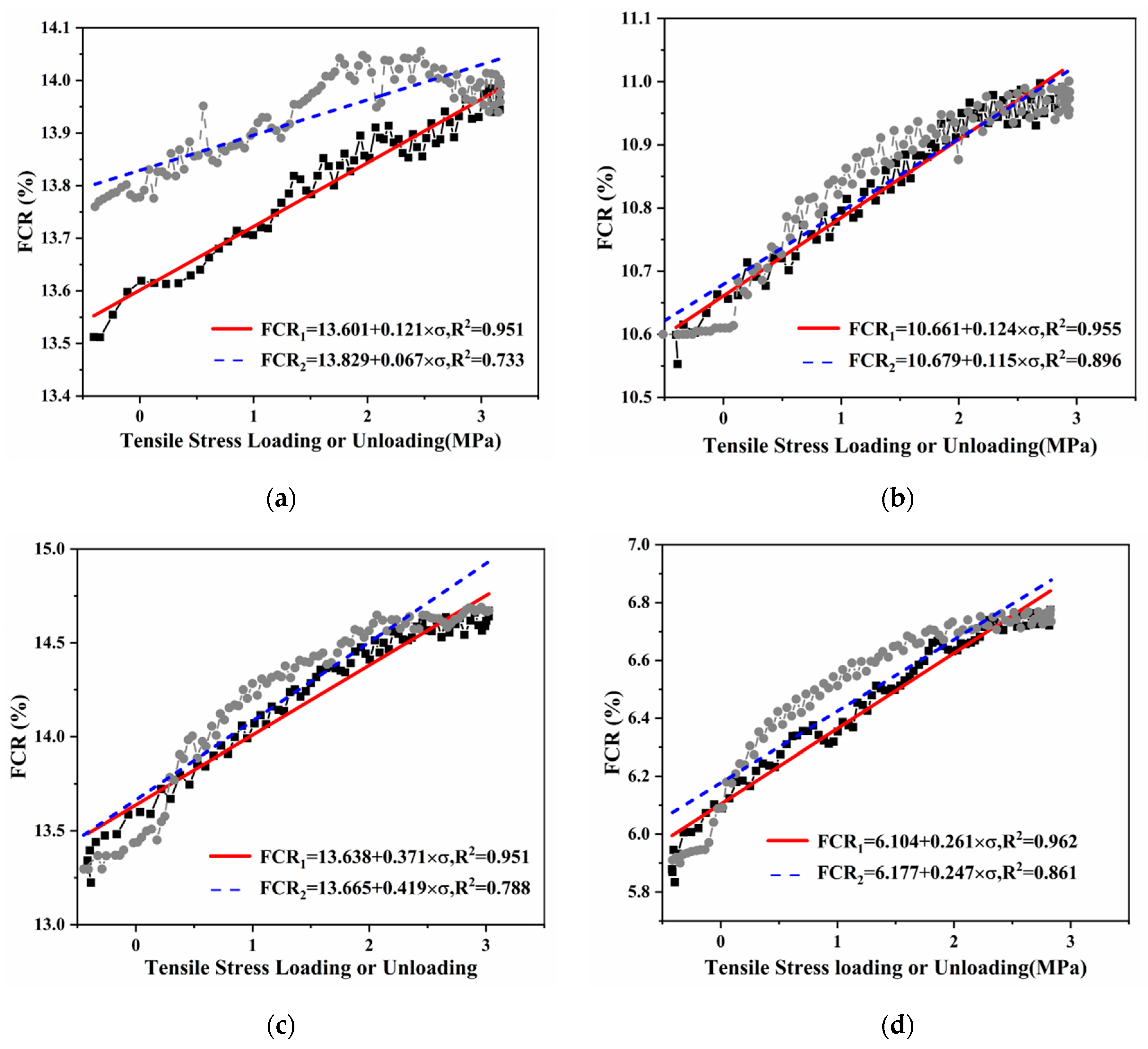

 The locations where adjacent conductive fillers are connected,
The locations where adjacent conductive fillers are connected,  the locations where adjacent conductive fillers are disconnected due to tension,
the locations where adjacent conductive fillers are disconnected due to tension,  the formation of a continuous electrical network due to excessive SCBA addition, and
the formation of a continuous electrical network due to excessive SCBA addition, and  the breakage of a continuous electrical network caused by tension.
the breakage of a continuous electrical network caused by tension.
 The locations where adjacent conductive fillers are connected,
The locations where adjacent conductive fillers are connected,  the locations where adjacent conductive fillers are disconnected due to tension,
the locations where adjacent conductive fillers are disconnected due to tension,  the formation of a continuous electrical network due to excessive SCBA addition, and
the formation of a continuous electrical network due to excessive SCBA addition, and  the breakage of a continuous electrical network caused by tension.
the breakage of a continuous electrical network caused by tension.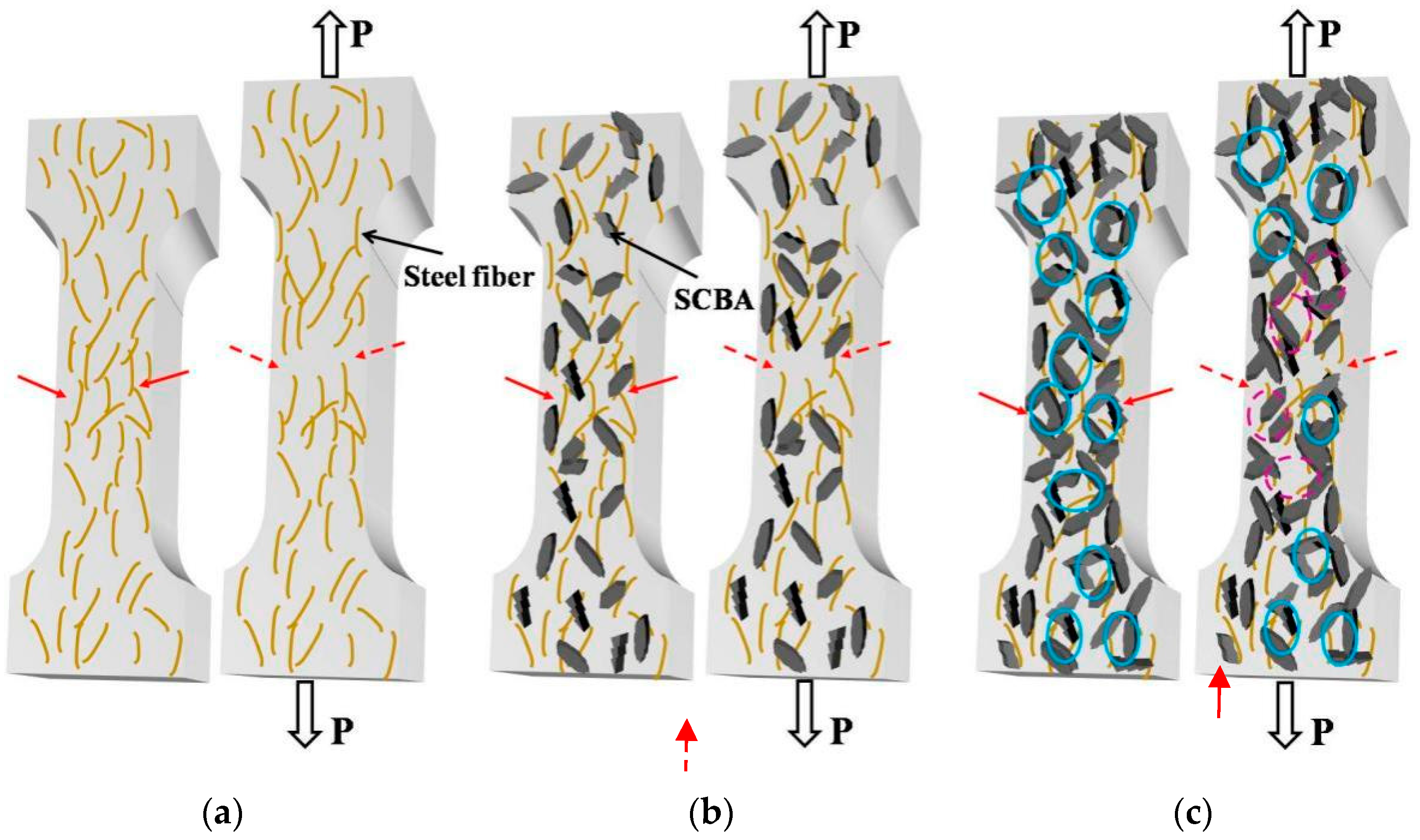
| C, wt% | H, wt% | N, wt% | Residual Rate of Calcinated Ash, wt% | Carbonation Degree | |
|---|---|---|---|---|---|
| S300 | 48.60 | 3.54 | 0.81 | 52.95 | 0.87 |
| S600 | 38.09 | 1.67 | 0.64 | 40.40 | 0.53 |
| S900 | 35.57 | 1.39 | 0.24 | 37.23 | 0.47 |
| Total Pore Volume a (cc/g) | Average Pore Diameter a (nm) | Specific Surface Area (m2/g) | |
|---|---|---|---|
| S300 | 4.53 × 10−3 | 33.64 | 0.54 |
| S600 | 1.90 × 10−1 | 2.84 | 267.18 |
| S900 | 1.54 × 10−1 | 3.02 | 204.54 |
| Composition wt% | CaO | Al2O3 | SiO2 | Fe2O3 | MgO | SO3 | Pozzolanic Content (SiO2 + Al2O3 + Fe2O3) |
|---|---|---|---|---|---|---|---|
| Portland cement | 18.6 | 5.5 | 18.6 | 3.7 | 3.5 | 2.2 | 27.8 |
| Silica fume | 0.8 | 0.9 | 92.3 | 1.5 | 1.5 | 0 | 94.7 |
| Fly ash | 5.6 | 24.2 | 45.1 | 0.9 | 2.5 | 2.1 | 70.2 |
| S300 | 4.0 | 10.5 | 57.9 | 1.9 | 3.4 | 2.8 | 70.3 |
| S600 | 3.7 | 10.9 | 71.9 | 2.4 | 3.5 | 1.4 | 85.2 |
| S900 | 2.9 | 9.8 | 75.2 | 2.1 | 1.9 | 1.4 | 87.1 |
| Mix | Cement | Silica Fume | Fly Ash | Water | SP | Steel Fiber | SCBA |
|---|---|---|---|---|---|---|---|
| Control | 1159.7 | 331.3 | 165.7 | 289.9 | 41.4 | 108.5 | 0 |
| SCBA300 | 1159.7 | 331.3 | 165.7 | 296.0 | 42.3 | 108.5 | 34.8 |
| SCBA600 | 1159.7 | 331.3 | 165.7 | 296.0 | 42.3 | 108.5 | 34.8 |
| SCBA900 | 1159.7 | 331.3 | 165.7 | 296.0 | 42.3 | 108.5 | 34.8 |
| SCBA0.3 | 1159.7 | 331.3 | 165.7 | 290.5 | 41.5 | 108.5 | 3.5 |
| SCBA0.9 | 1159.7 | 331.3 | 165.7 | 291.7 | 41.7 | 108.5 | 10.4 |
| SCBA3.0 (SCBA600) | 1159.7 | 331.3 | 165.7 | 296.0 | 42.3 | 108.5 | 34.8 |
| SCBA9.0 | 1159.7 | 331.3 | 165.7 | 308.2 | 44.0 | 108.5 | 104.4 |
| Control | SCBA300 | SCBA0.3 | SCBA0.9 | SCBA 3.0 (SCBA600) | SCBA9.0 | SCBA900 | |
|---|---|---|---|---|---|---|---|
| Fluidity | 209 | 212 | 201 | 196 | 191 | 138 | 206 |
| Consistency | 93 | 81 | 85 | 58 | 44 | 31 | 57 |
| Sample | FCR Range (%) | Linearity for Loading Curves (%) | Linearity for Unloading Curves (%) | Hysteresis (%) |
|---|---|---|---|---|
| Control | 13.5–14.0 | 14.0 | 60.0 | 50.0 |
| SCBA0.3 | 10.5–11.0 | 8.8 | 17.0 | 18.0 |
| SCBA0.9 | 13.2–14.7 | 16.7 | 20.0 | 13.3 |
| SCBA3.0 | 5.8–6.8 | 18.9 | 21.0 | 19.0 |
| Sample | Total FCR Range (%) | Average FCR Amplitude in One Cycle (%) | Sensitivity (%/MPa) | Repeatability (%) |
|---|---|---|---|---|
| Control | 11.9–14.0 | 0.25 | 0.08 | 51.6 |
| SCBA0.3 | 9.4–11.0 | 0.40 | 0.13 | 10.7 |
| SCBA0.9 | 10.7–14.7 | 1.45 | 0.48 | 5.3 |
| SCBA3.0 | 5.1–6.8 | 0.95 | 0.32 | 7.0 |
Disclaimer/Publisher’s Note: The statements, opinions and data contained in all publications are solely those of the individual author(s) and contributor(s) and not of MDPI and/or the editor(s). MDPI and/or the editor(s) disclaim responsibility for any injury to people or property resulting from any ideas, methods, instructions or products referred to in the content. |
© 2023 by the authors. Licensee MDPI, Basel, Switzerland. This article is an open access article distributed under the terms and conditions of the Creative Commons Attribution (CC BY) license (https://creativecommons.org/licenses/by/4.0/).
Share and Cite
Lian, J.; Wang, Y.; Fu, T.; Easa, S.M.; Zhou, Y.; Li, H. Mechanical, Electrical, and Tensile Self-Sensing Properties of Ultra-High-Performance Concrete Enhanced with Sugarcane Bagasse Ash. Materials 2024, 17, 82. https://doi.org/10.3390/ma17010082
Lian J, Wang Y, Fu T, Easa SM, Zhou Y, Li H. Mechanical, Electrical, and Tensile Self-Sensing Properties of Ultra-High-Performance Concrete Enhanced with Sugarcane Bagasse Ash. Materials. 2024; 17(1):82. https://doi.org/10.3390/ma17010082
Chicago/Turabian StyleLian, Jinkang, Yulin Wang, Tengfei Fu, Said M Easa, Yan Zhou, and Huawei Li. 2024. "Mechanical, Electrical, and Tensile Self-Sensing Properties of Ultra-High-Performance Concrete Enhanced with Sugarcane Bagasse Ash" Materials 17, no. 1: 82. https://doi.org/10.3390/ma17010082
APA StyleLian, J., Wang, Y., Fu, T., Easa, S. M., Zhou, Y., & Li, H. (2024). Mechanical, Electrical, and Tensile Self-Sensing Properties of Ultra-High-Performance Concrete Enhanced with Sugarcane Bagasse Ash. Materials, 17(1), 82. https://doi.org/10.3390/ma17010082









